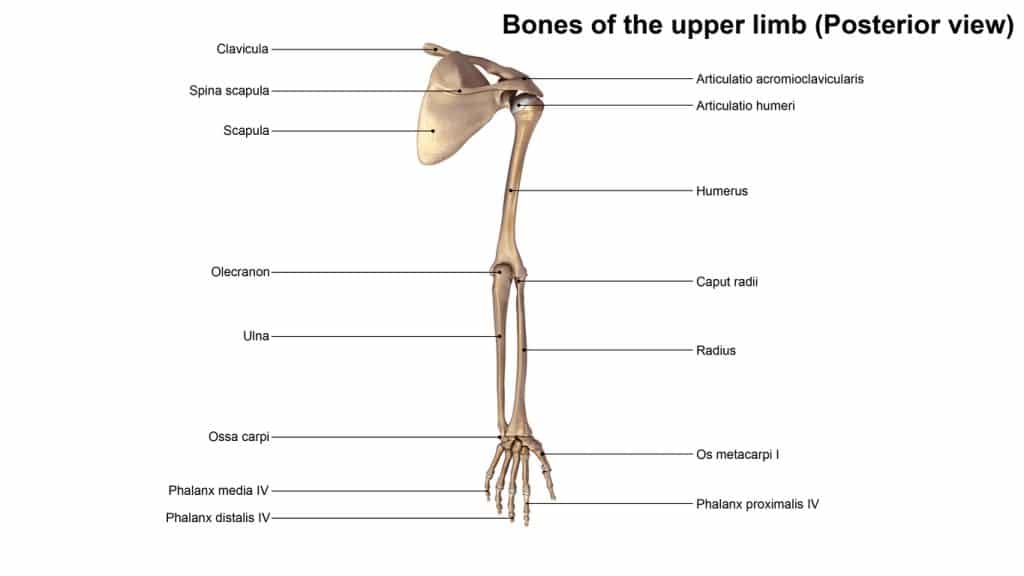What Is a Radial Fracture?
The radius and ulna are the two bones of the forearm that connect the elbow to the wrist. The radius is the thicker of these two bones and runs along the thumb side. Interestingly, the radius is shorter than the ulna, and it rotates when you twist your wrist so that it is always on the outside of the elbow.
The radius is also the bone in the arm that is broken most often. Common causes of fractured radial bones are falls, car accidents, and injuries during sports. When we extend our arms out to catch ourselves in a fall, the radius takes on nearly all that load.
When it breaks, it typically does so near the wrist, which is the bone’s distal end. You’ll often hear orthopedic specialists refer to this type of break as a distal radial fracture, a radial head fracture, or a radial wrist fracture. While these fractures are somewhat common, they can range in severity and sometimes require surgery.

The Radius
The radius provides leverage for lifting and helps enable the hand, wrist, and forearm to rotate. When broken, the break (also called a fracture) can occur in various patterns. The type of fracture is classified by severity and the direction of the force that caused the injury.
Classifications of radial fractures include:
- Colles fracture — The most common type of radius fracture; occurs when the hand and fingers are pointed back toward the arm, as during a fall
- Smith fracture — Occurs while the hand is bent downward, with the fingers pointed toward the underside of the wrist
- Intra-articular fracture — A fracture that extends into the wrist joint
- Extra-articular fracture — A fracture that does not extend into the wrist joint
- Open fracture — A fracture where the broken bone breaks through the skin
- Comminuted fracture — A fracture where the bone breaks into more than two pieces
Symptoms of a Radial Fracture
Symptoms of a radial fracture include immediate pain, bruising, and swelling. The wrist often looks deformed and appears bent in an odd position.
In particularly severe fractures, nerves can be damaged and result in numbness in the fingers. If you’ve hurt your wrist and cannot feel your fingers, go immediately to the emergency room.
Fractured Radial Diagnosis
To determine the type and severity of the injury, your orthopedic specialist uses a physical exam and diagnostic imaging such as an X-ray, MRI, or CT scan. For patients over age 50, a bone density scan called a Dexa might be used to evaluate the presence of osteoporosis.
Your doctor will look to see if the broken bone has shifted, if the bone is broken in multiple places, and whether any surrounding tissues or nerves are damaged. Once they’ve determined the extent of the injury, they’ll talk with you about appropriate treatment options.
Treatment for a broken radius depends on the type and severity of the break as well as whether the ulna or any other bones or surrounding tissues or nerves are damaged.
Do you need a cast for a radial head fracture?

During treatment and healing, the broken bone needs to be realigned and held in place. Your orthopedic specialist will aim for the least invasive procedures to achieve this goal and restore hand and wrist functionality.
If the broken bones of the radius are misaligned, your doctor will use a procedure called a reduction to realign the bones. This is done under local anesthesia and is necessary for the bone to heal properly and without deformity.
For less severe fractures and people with higher bone density, the reduction procedure plus a splint and/or plaster cast may be sufficient to realign the bone and hold it in place while it heals. Your orthopedic specialist may use a cast that extends above the elbow or one that simply covers the wrist and forearm. The injured arm is often immobilized with a sling to keep it still and close to the body. Most people wear their casts or splints for around 6 weeks.
To help manage the pain of a broken radius, non-prescription medications like ibuprofen and acetaminophen and elevating your arm can be helpful, especially during the first few days.
If you have osteoporosis or if your break resulted in multiple fragmentations of bone, you may be checked as regularly as weekly to gauge realignment and healing.
Does a radial head fracture require surgery?
Severe breaks, those not realigning effectively, and those likely to misalign once again may require surgery. The timeline for preliminary healing from most radial fracture surgeries is about 6 weeks.
Two common surgical techniques for radial fractures are internal fixation and external fixation:
- Internal fixation — In internal fixation, the broken bones are stabilized using plates, screws, and/or pins inserted through and beneath the skin. These tools realign the bones and hold them in place while they heal. Sometimes these devices are left in place permanently, and in other instances, they may be removed.
- External fixation — In external fixation, the main stabilizing apparatuses are placed externally and anchored through the skin into the bone using pins. This type of fixation is more common when there are multiple breaks in the bone. This type of device is often worn for three to six weeks.
Stiffness After Radial Head Fracture

Whether you are treated surgically or non-surgically, following your orthopedic specialist’s instructions regarding physical therapy exercises will be important. Physical therapy stretches and strengthens your wrist, elbow, and shoulder to maintain strength and flexibility during this period of prolonged inactivity. These exercises help you regain range of motion and effective use of your arm in day-to-day life.
Complete healing from a radial fracture can take up to a year, though wrist stiffness may persist for longer in some individuals. Generally, you should be comfortable returning to most aspects of your daily routine in about 3 months.
If you would like to talk to one of our orthopedic specialists or if you have questions about an arm injury or symptoms, please get in touch with us or comment below.
Leave a Reply